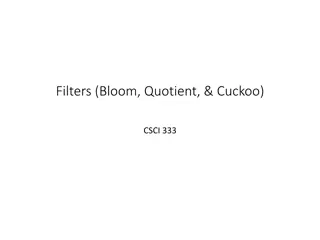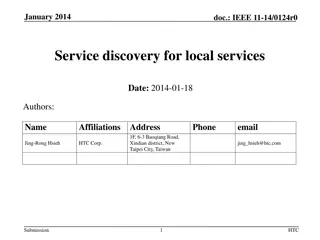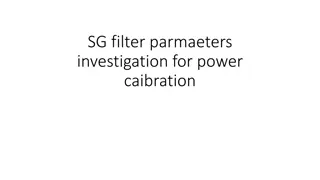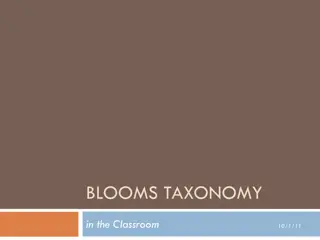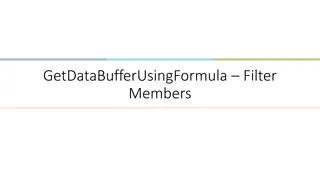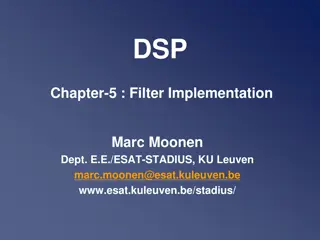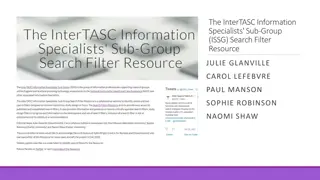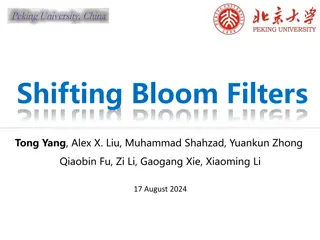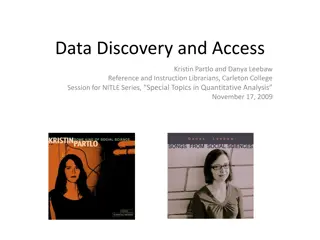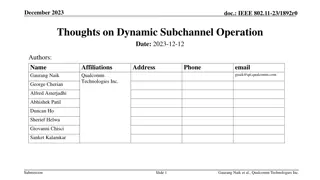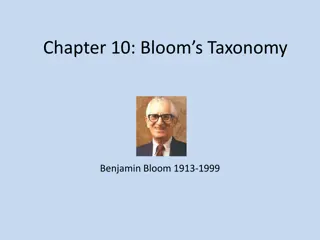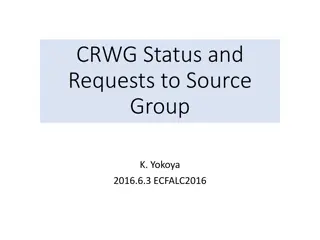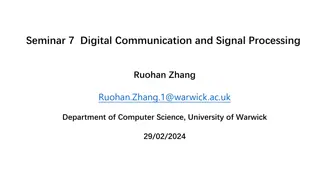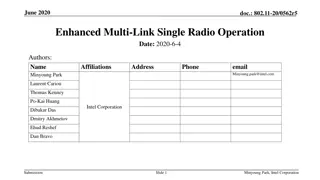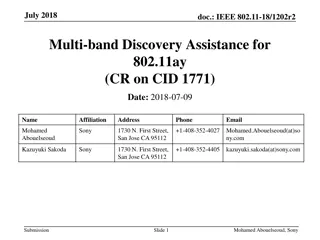Dynamic Bloom Filter Operation for Pre-Association Service Discovery
This document outlines a proposal for a Dynamic Bloom Filter Operation as part of a Pre-Association Service Discovery protocol to efficiently and quickly identify services offered by devices in a network. The design goals include efficiency, speed of discovery, and scalability. Challenges addressed include reducing overhead, supporting a large number of services, and handling scenarios with multiple queries for services. The proposal suggests using Service Information IE for flexible service discovery based on dynamic Bloom filter operation.
Download Presentation

Please find below an Image/Link to download the presentation.
The content on the website is provided AS IS for your information and personal use only. It may not be sold, licensed, or shared on other websites without obtaining consent from the author. Download presentation by click this link. If you encounter any issues during the download, it is possible that the publisher has removed the file from their server.
E N D
Presentation Transcript
July 2014 doc.: IEEE 11-14/0877r2 Generic Service Discovery Proposal: Dynamic Bloom Filter Operation Date: 2014-07-14 Authors: Name SK Yong Affiliations Address Apple Phone email skyong@apple.com chartman@apple.com 3 Infinite Loop, Cupertino, CA Chris Hartman yongliu@apple.com ericwong@apple.com Yong Liu Eric Wong Submission Slide 1 SK Yong et.al., Apple
July 2014 doc.: IEEE 11-14/0877r2 Agenda Problem Statement & Design Goals Challenges Propose Solution: Dynamic Bloom Filter Operation Conclusion Submission Slide 2 SK Yong et.al., Apple
July 2014 doc.: IEEE 11-14/0877r2 Design Goals In designing a pre-association service discovery protocol, the following requirements must be met and save battery life of portable devices service for better user experience in the network Goal 1: Efficiency- light weight discovery to not congesting the wireless network Goal 2: Speed of discovery- quickly identifying the right devices that offer the Goal 3: Scalability- ability to support beyond the typical number of services offered Submission Slide 3 SK Yong et.al., Apple
July 2014 doc.: IEEE 11-14/0877r2 Challenges Only limited information can be included in the beacon and probe response: How to reduce overhead? Scalability issues: how to support practically large number if not unlimited number of services for future extensibility? How to handle in use case (like in mall, airport) where a lot of STAs queries for services? Submission Slide 4 SK Yong et.al., Apple
July 2014 doc.: IEEE 11-14/0877r2 Proposal: Dynamic Bloom Filter Operation Assumption: The Pre-association Service Discovery protocol is built on top of ANQP based 802.11u frame work currently used in Passpoint. It is important to note that the proposed solution can be equally applicable to other framework To meet the design goals and alleviate the challenges highlighted in the previous slides, the Service information IE (see slide 6) is proposed to enable flexible pre-association service discovery based on dynamic Bloom filter operation. AP should have the flexibility to advertise directly several services that are commonly used in a particular scenario (what services to be advertised directly is out of scope) e.g. in Mall, maybe a directory/map service with location service, on-sale and coupon service vs printing service Submission Slide 5 SK Yong et.al., Apple
July 2014 doc.: IEEE 11-14/0877r2 Option 1: Service Information IE Element ID field is TBD Length field is 1 bytes whose value is set to 1 + (m/8) + 6N. Note that m can be derived from the Bloom Filter Information field and thus there is no need to have an extra length field separately to indicate the length of the variable m-bit Service Hint Map Bloom Filter Information is 2 byte B0-B8 are used to indicate the maximum number of services, n that can be offered by the AP. The maximum number of services are 512 B9-B12 are used to indicate the number of hash functions, k (out of total of 16) used by the Bloom filter. e.g. 0001 means the first 2 hash functions (i.e. H1 and H2) will be used B13-B15 are reserved Service Hash field is an optional field up to N number of Service Hashes Submission Slide 6 SK Yong et.al., Apple
July 2014 doc.: IEEE 11-14/0877r2 Option 2: Service Information IE Element ID field is TBD Length field is 2 bytes whose value is set to 1 + (m/8) + 6N. Note that m can be derived from the Bloom Filter Information field and thus there is no need to have an extra length field separately to indicate the length of the variable m-bit Service Hint Map Bloom Filter Information is 2 byte B0-B11 are used to indicate the maximum number of services, n that can be offered by the AP. The maximum number of services are 4096 B12-B15 are used to indicate the number of hash functions, k (out of total of 16) used by the Bloom filter. e.g. 0001 means the first 2 hash functions (i.e. H1 and H2) will be used Service Hash field is an optional field up to N number of Service Hashes Note: The Service Hint Map plus Bloom filter information plus Service Hash may not fit into a single element and therefore the data following the length field of a Service Hash (if present) or Service Hint Map, a fragmentation using Fragment elements Submission Slide 7 SK Yong et.al., Apple
July 2014 doc.: IEEE 11-14/0877r2 Option 3: Service Hint Map Type Length (Octets) Value Scope/Country Code Name Service Hint Map TBD variable See below figure N/A Length field is variable length bytes up to 2304 bytes, whose value is set to 2 + (m/8) + 6N. Note that m can be derived from the Bloom Filter Information field and thus there is no need to have an extra length field separately to indicate the length of the variable m-bit Service Hint Map Bloom Filter Information is 2 byte B0-B11 are used to indicate the maximum number of services, n that can be offered by the AP. The maximum number of services are 4096 B12-B15 are used to indicate the number of hash functions, k (out of total of 16) used by the Bloom filter. e.g. 0001 means the first 2 hash functions (i.e. H1 and H2) will be used Service Hash field is an optional field up to N number of Service Hashes Submission Slide 8 SK Yong et.al., Apple
July 2014 doc.: IEEE 11-14/0877r2 Dynamic Bloom Filter Operation (1) The m-bit Service Hint Map provides hint of the services offered by the infrastructure AP/STA in a compact way than directly advertising individual services (Goal 1 and 3) Operation steps/procedures: AP selects numbers of services, n to be advertised AP selects an acceptable false positive rate, Pf, depending on the design tradeoff and computes the required number of hash functions, k AP computes value of m i.e. the Bloom filter size based on k and n values The STA can infer the value of Pf by decoding the Service Information IE from the received beacons. If Pf turns out to be low (e.g. <1%), then STA may directly send GAS Query to obtain more information about the service since STA has high confidence that the service was indeed provided by the network (Goal 2) If Pf turns out to be high (e.g. >10%), STA may want to send Probe Request to confirm the right service before sending GAS Query Submission Slide 9 SK Yong et.al., Apple
July 2014 doc.: IEEE 11-14/0877r2 Dynamic Bloom Filter Operation (2) If the number of services offered by the AP is large and Pf is low, AP may not include Service Hash(es) in the Beacon Service Hash field is an optional field which may be included in the beacon to reduce STAs from flooding the network with probe requests. The protocol enables up to N Service Hashes may be included. This enables the direct advertisement of commonly used services (which scenario/deployment specific) than providing hint (Goal 1). Any additional Service Hashes are available via ANQP query Submission Slide 10 SK Yong et.al., Apple
July 2014 doc.: IEEE 11-14/0877r2 Dynamic Bloom Filter Operation (3) Submission Slide 11 SK Yong et.al., Apple
July 2014 doc.: IEEE 11-14/0877r2 Example of Pre-association Discovery Flow Submission Slide 12 SK Yong et.al., Apple
July 2014 doc.: IEEE 11-14/0877r2 Hash Functions for Bloom Filter B12-B15 Hash Function 0000 H1 0001 H2 0010 H3 0011 H4 0100 H5 0101 H6 0110 H7 0111 H8 1000 H9 1001 H10 1010 H11 1011 H12 1100 H13 1101 H14 1110 H15 1111 H16 Submission Slide 13 SK Yong et.al., Apple
July 2014 doc.: IEEE 11-14/0877r2 Service Hint-Map vs Service Hash Efficiency A Bloom filter with Pf of 0.001, 0.01, 0.1 and an optimal value of k (10, 7, 4) , requires m of 14.4, 9.6, 4.8 bits per element, respectively regardless of the size of the elements. Compare to Hash-value this is 70%, 80%, 90% reduction in space The Pf decreases as m increases, and increases as n increases. Submission Slide 14 SK Yong et.al., Apple
July 2014 doc.: IEEE 11-14/0877r2 Conclusions The proposed Pre-Association Service Discovery Protocol based on Dynamic Bloom Filter Operation meeting the goals of Efficiency Speed of discovery Scalability The protocol is very flexible and can be deployed in many different scenarios e.g. Wi-Fi Infrastructure and P2P network Submission Slide 15 SK Yong et.al., Apple



